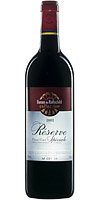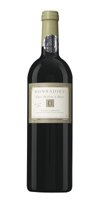 Although I realize that I may be relegating myself to the margins, I'd like to blog about a magazine article that was not written in English and is not available online. (If you're in Montreal you still might find this article lying around in the April 6 edition of Voir -- "Voluptueux Chocolat Noir" by Evelyne Fiorenza in the VLV section.)
Although I realize that I may be relegating myself to the margins, I'd like to blog about a magazine article that was not written in English and is not available online. (If you're in Montreal you still might find this article lying around in the April 6 edition of Voir -- "Voluptueux Chocolat Noir" by Evelyne Fiorenza in the VLV section.)
The piece is about chocolate (specifically the chocolate Poulain makes, which is my personal favourite) and matching wine with it. It falls on the pro-pairing side of this trendy culinary debate.
Here's my attempt at a partial translation:
- Good dark chocolate -- like chocolate bars from Poulain, which was founded in France's Loire Valley in 1848 by Victor Auguste Poulain and is now distributed by Cadbury Adams Canada -- makes for a wonderful pairing with wine.
- A red wine, especially those featuring the grapes Cabernet Sauvignon or Syrah, marries well with dark chocolate. Jordan Lebel, an associate professor at Cornell University's Hotel School, says that it is these wines that have pronounced tannins well as earthy aromas, setting up a near-perfect complement for pure and rich chocolate.
- Cognac is also recommended, especially if you’re eating chocolate with raisins or dried fruits like cranberries, apricots or cherries.
- Like wine, chocolate is temperature sensitive: it should be served at 19 to 25 degrees Celsius.
Other Lebel
findings:
Poulain Noir Café, 64 per cent cocoa
Tasting notes: Dark chocolate with roasted coffee beans and caramelized cocoa nibs -- has dark coffee taste with undertones of caramel; distinct coffee flavour means it could be paired with coffee or a younger, more nervy red wine.
Poulain Noir, 76 per cent cocoa
Tasting notes: Rich, velvety, smooth dark chocolate with a hint of spice, bold cocoa notes and a fruity finish -- would go well with a bolder wine; Big-bodied red wines such as Cabernet Sauvignon and Syrah are recommended.
Poulain Ultime Noir, 86 per cent cocoa
Tasting notes: Strong, full-bodied dark chocolate for connoisseurs -- light, fruity wine notes with deep nutty flavours, and a caramel finish; would go with malty stout beers or aged Cognac or Armagnac.
Note to my American cousins who may not have Poulain to taste:
Winecentric is a new wine blog (a well done one too) that posted on wine and chocolate last month. Check out how the Winemaster
pairs Hershey's with Merlot.
HOPPING LIKE A CHOCOLATE BUNNY
It turns out this Lebel guy really gets around with all his chocolate talk. When he was interviewed by
CTV News, he said: "Let's say you're having a dinner and just finishing a bottle of wine, instead of going for a complicated dessert that will take hours to prepare in the kitchen, you can break off a piece of chocolate and see how well it goes."
Well, that's not rocket science -- I break off a little chocolate for myself after dinner almost every night. It's just too darn easy to keep some of the stuff on hand.
One only needs to toss a small supply in the fridge for safe long-term storage and then there's always dessert when it's needed. That way you won't have to rely on the errant eggs from last year's Easter hunt that you find hiding and forgotten behind your wine rack.
 The debut appearance by Weingolb on Alawine's 100 Top Wine Blog Rankings has also just been announced.
The debut appearance by Weingolb on Alawine's 100 Top Wine Blog Rankings has also just been announced.  Weingolb is number 43! (See clickable image.)
Weingolb is number 43! (See clickable image.)




















